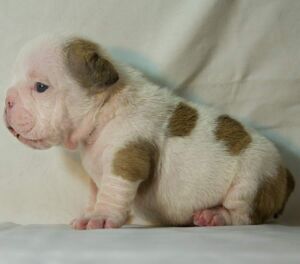Distichiasi
The most frequent eye diseases in the English bulldog are: hypertrophy of the gland of the third eyelid, distichiasis, entropion, ectropion. Distichiasis is the abnormal growth of eyelashes (single or multiple) at the edge of the eyelid. The eyelashes, rubbing on the cornea, cause irritation or even injuries. The resulting irritation of the eye increases tearing and is often followed by a "blink" of the eye itself. Distichiasis is a very common pathology in the English bulldog (predisposed breed) and in all dogs in general. Diagnosis is made through a clinical examination: with a magnifying glass, the veterinarian will be able to easily identify the eyelashes that grow in an "abnormal" direction (the owner, on the other hand, notices the presence of the disease by noticing mucus in the eye). The simplest treatment is the removal of the eyelashes: the veterinarian can teach you a simple procedure for removing the eyelashes with tweezers, a simple procedure that will be repeated every time they reform. If this procedure is too complex, the veterinarian can perform electrodepilation which, despite having a much longer duration, requires general anesthesia. Some vets (usually specialists) also perform cryosurgery. It is always good to remember that, in the case of specific pathologies (such as ophthalmology, for example) it is a good idea to contact specialist doctors, in the case of Veterinary Ophthalmologists.
Read more by clicking on the images or categories
- All
- Dermatology
- Eye Pathologies
- Prophylaxis and Vaccines
- Bulldog Breathing
- Reproduction
- Various

LAMENESS

OTITIS

HIP DYSPLASIA

INGROWN TAIL

SWIMMING PUPPY SYNDROME

CHONDROPROTECTED

OTOHEMATOMA

PYOMETRA

MONORCHIDISM AND CRYPTORCHIDISM

HYSTERIC PREGNANCY

HEAT AND FALSE HEAT

PROLAPSE OF THE URETHRA

DISTICHIASI

ENTROPION

HYPERTROPHY OF THE GLAND OF THE THIRD PALPEBRA (CHERRY EYE)

HEAT STROKE

WHY DOES THE BULLDOG BREATHE BAD?

LEPTOSPIROSIS

VACCINAL PROPHYLAXIS

LEISHMANIOSIS

PHILARIOSIS

ATOPIC ALLERGY

PIODERMITE

INTERDIGITAL CYSTS

PODODERMATITIS

ACNE

CYCLIC ALOPECIA OF THE FLANK

DEMODECTIC MANGE
